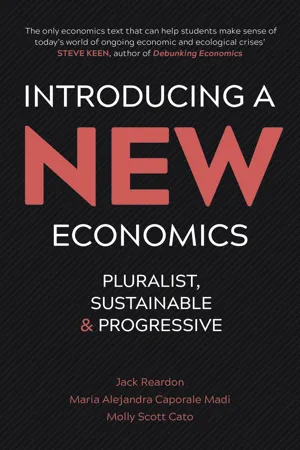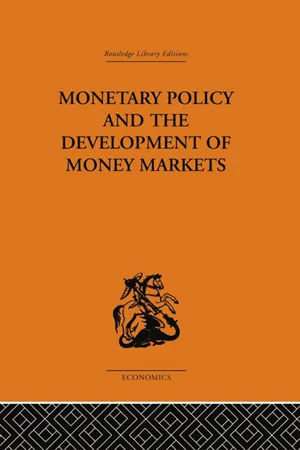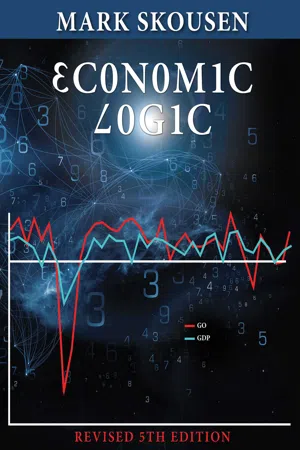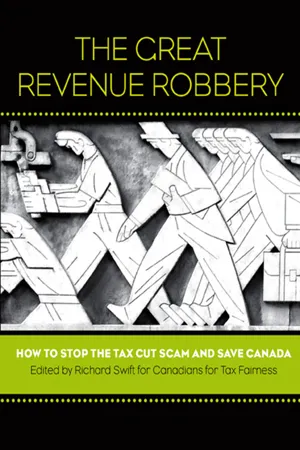Economics
Investment Spending
Investment spending refers to the expenditure by businesses on capital goods such as machinery, equipment, and buildings, with the aim of increasing future production capacity. It is a key component of aggregate demand and can have a significant impact on economic growth. Investment spending is influenced by factors such as interest rates, business confidence, and expectations of future profitability.
Written by Perlego with AI-assistance
Related key terms
4 Key excerpts on "Investment Spending"
- eBook - ePub
Introducing a New Economics
Pluralist, Sustainable and Progressive
- Jack Reardon, Maria Alejandra Caporale Madi, Molly Scott Cato(Authors)
- 2017(Publication Date)
- Pluto Press(Publisher)
Investment is the most volatile component of GDP, and it is independent of previous levels of national income; that is to say, investment is an autonomous form of spending. It is determined by interest rates, business confidence, taxes and capacity utilisation. If firms are confident of the future, they will invest more, all else being equal; and, conversely, uncertainty about the future will reduce investment.Total (or gross) Investment Spending is composed of:• spending on capital goods, i.e. the purchase of machinery and equipment either to replace existing capacity that is wearing out or to increase capacity (also called ‘fixed capital formation’) • inventories that firms hold to satisfy miscalculated demand on the final goods they produce.Because capital goods are used in the production of other goods and services, they will wear out or depreciate. For example, a nuclear power plant, thanks to the intensive energy of the fission process, lasts approximately 40 years and then will have to be discarded and replaced. This wear and tear from normal use, i.e. depreciation , can be calculated either all at once or, more usually, pro-rated each year.Consumption and investment are invariably linked. A change in Investment Spending, such as building a nuclear power plant, changes income, which then changes consumption and savings. The exact mix depends on the MPC and MPS.13.7 A BRIEF NOTE ON FRIEDRICH VON HAYEK (1899–1992)
A fundamental problem in economics, according to the Austrian economist Friedrich von Hayek, is coordinating the plans of many individuals. The main advantage of a competitive economic order, in Hayek’s view, is that rational individuals respond to price signals, which convey the relevant information available in markets for the purpose of economic calculus. In his view, competition, through the price market system, leads to such coordination (Hayek, 1944). - J.S.G. Wilson(Author)
- 2013(Publication Date)
- Routledge(Publisher)
1Investment in a Monetary Economy1I
Investment is a term used very loosely in the economic literature and all too frequently without any attempt at definition. Yet it is possible to defend an attitude which refuses to regard precise definition as an end in itself. The businessman, for example, rightly regards ‘investment’ not as a logical category with strictly definable limits, but as a rough description of a type of activity. To the businessman and to the economist, it is the purpose of any particular expenditure which matters. And, indeed, if we take a representative sample of definitions of investment, they all have this in common. Fraser, for instance, defines investment in a money economy—which is the sort of economy we are concerned with—as ‘the use of monetary resources for the acquisition of wealth of a relatively illiquid type’2 and Keynes obviously had a similar definition in mind when he divided current output into ‘(a ) the flow of liquid goods and services which are in a form available for immediate consumption and (b) the net flow of increments (after allowing for wastage) to capital goods and loan capital . . . which are not in a form available for consumption’.3 But what are goods of ‘a relatively illiquid type’? What is ‘capital’? Must we not define ‘capital’ before we can define ‘investment’ and as a condition of defining investment?It is no part of our present purpose to embark upon a re-examination of the basic concepts of capital theory. That ground has already received its fair share of attention, though with no very definite results. Since there is still no general agreement as to what classes of goods should be regarded as ‘capital’, it is fruitless to define ‘gross investment’ as all expenditure on the provision or replacement of those classes of goods. It is much better to consider the purpose for which a good is used than the physical form in which it happens to appear. In this paper, therefore, the emphasis will be on the purpose of an expenditure. If goods are used in the production of further goods, that is ‘investment’. In other words, investment is ‘the act of applying a unit of input in any process of production’.4- eBook - ePub
- Mark Skousen(Author)
- 2017(Publication Date)
- Regnery Capital(Publisher)
Second, gross business investment is typically larger than the final output. This is a more subtle concept. In the example above, note that the total spending is $11.50, while final output (the cup of coffee) is valued at $5. In this example, gross business spending is equal to:$11.50 (total spending) - $5 (consumer/retail price) = $6.50By subtracting the value of the consumer product of $5 from total spending at all stages of production, the value of intermediate spending, $6.50, is obtained. Thus, the second proposition is confirmed, business investment is a larger segment of the economy than spending by the final consumer. There may be times when the value of a retail product may be worth more than the gross intermediate expenditures. For example, when there is a sudden demand for a product driven by a fad and the price for the product skyrockets beyond the costs of production. This situation is highly unlikely to last on a macro scale for all goods and services.The point of this exercise is to emphasize the relative importance of business investment in the economy, which is much more significant than commonly recognized. The standard established view is that consumer spending (the final retail stage) is the largest and most important sector in the economy rather than business investment. However this is not likely to be the case. Business investment is invariably more important than consumer spending. (See Chapter 17 .)MEASURING THE MACRO ECONOMYStatistics on spending have been compiled for many years. Gross Domestic Product (GDP), which measures spending on final goods and services, is reported quarterly and provides the most up-to-date data. Harvard economist Simon Kuznets, highlighted at the end of this chapter, invented GDP in the 1940s. By focusing solely on final spending in the economy, GDP overemphasizes the relative size of consumer spending in the economy. However, GO, total spending at all stages of production, is a new statistic based on data from the annual input-output tables compiled by the Bureau of Economic Analysis - eBook - ePub
- Richard Swift, Richard Swift(Authors)
- 2013(Publication Date)
- Between the Lines(Publisher)
5The Failure of Corporate Tax Cuts to Stimulate Business Investment SpendingJIM STANFORDIntroduction
INVESTMENT IN FIXED CAPITAL ASSETS is a crucial driver of economic growth, job creation, technological change, and productivity growth.1 In a capitalist economy, most such investment is undertaken by private businesses (although public investment spending plays an important supplementary role in capital accumulation). Hence the vibrancy and success of business Investment Spending is central to the overall state of the economy.2 When aggregate Investment Spending is high as a share of total GDP, economies tend to grow faster, to experience faster productivity improvements,3 and to generate stronger income growth. This was true in Canada during the 1960s and 1970s (when total national capital spending accounted for over 20 per cent of GDP), and it is true today in high-investment economies such as Korea, China, and Brazil.Capital spending by business in Canada in recent years has been disappointing. Business spending declined more than any other category of domestic expenditure as Canada entered the recession of 2008–09. Yet business investment recovered more slowly from the recession than any other category of spending. Indeed, the business sector is the only sector in Canada’s economy that was still spending less at the end of 2011 than in autumn 2008, before the recession started. In contrast, consumer spending and government spending both increased substantially (partly as a result of pro-active stimulus efforts, including lower interest rates and discretionary fiscal policy). In short, business Investment Spending was the major source of Canada’s recent downturn, and the slowness of the recovery in business spending is a key reason why Canada’s recovery from the recession is still uncertain, sluggish, and incomplete. It is worth noting that this sharp downturn in business investment occurred precisely coincident with another round of reductions in federal corporate income taxes, which were cut by the Harper government from 22.1 per cent in 2007 (including the former 1.1 per cent federal surtax) to 18 per cent by 2010. Whatever impact this 4-point reduction in federal corporate income taxes may have had (or not had) on business investment, it was vastly overwhelmed by other macroeconomic factors, which proved far more important in determining business investment spending.
Index pages curate the most relevant extracts from our library of academic textbooks. They’ve been created using an in-house natural language model (NLM), each adding context and meaning to key research topics.



